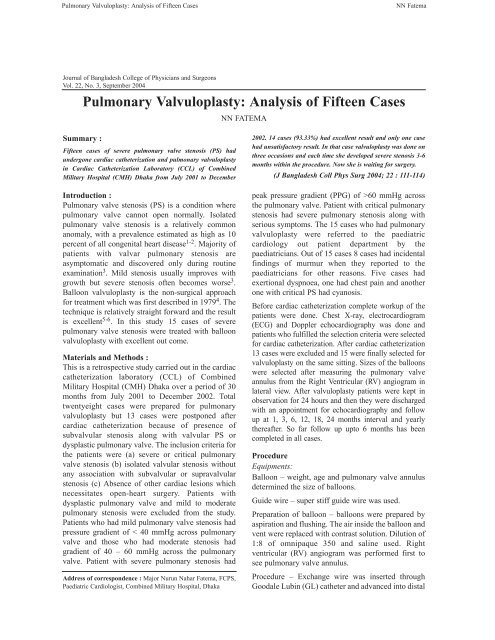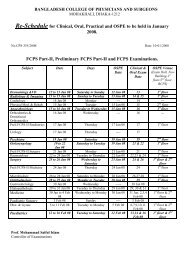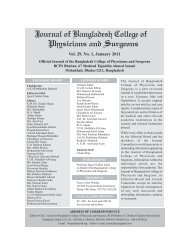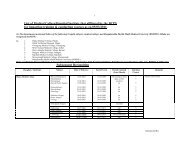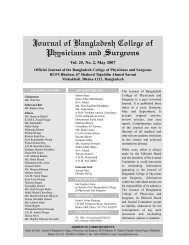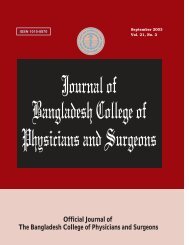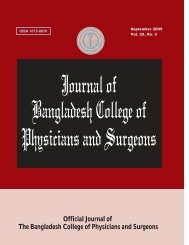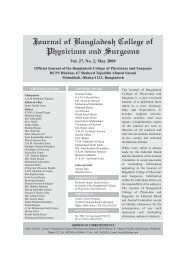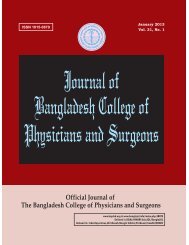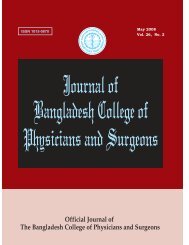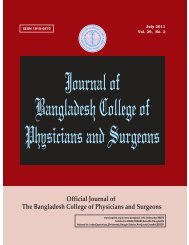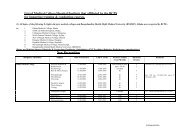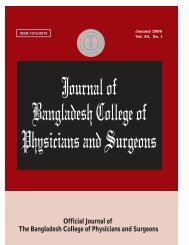September 2004 - bcps
September 2004 - bcps
September 2004 - bcps
You also want an ePaper? Increase the reach of your titles
YUMPU automatically turns print PDFs into web optimized ePapers that Google loves.
Pulmonary Valvuloplasty: Analysis of Fifteen CasesNN FatemaJournal of Bangladesh College of Physicians and SurgeonsVol. 22, No. 3, <strong>September</strong> <strong>2004</strong>Pulmonary Valvuloplasty: Analysis of Fifteen CasesNN FATEMASummary :Fifteen cases of severe pulmonary valve stenosis (PS) hadundergone cardiac catheterization and pulmonary valvuloplastyin Cardiac Catheterization Laboratory (CCL) of CombinedMilitary Hospital (CMH) Dhaka from July 2001 to DecemberIntroduction :Pulmonary valve stenosis (PS) is a condition wherepulmonary valve cannot open normally. Isolatedpulmonary valve stenosis is a relatively commonanomaly, with a prevalence estimated as high as 10percent of all congenital heart disease 1-2 . Majority ofpatients with valvar pulmonary stenosis areasymptomatic and discovered only during routineexamination 3 . Mild stenosis usually improves withgrowth but severe stenosis often becomes worse 3 .Balloon valvuloplasty is the non-surgical approachfor treatment which was first described in 1979 4 . Thetechnique is relatively straight forward and the resultis excellent 5-6 . In this study 15 cases of severepulmonary valve stenosis were treated with balloonvalvuloplasty with excellent out come.Materials and Methods :This is a retrospective study carried out in the cardiaccatheterization laboratory (CCL) of CombinedMilitary Hospital (CMH) Dhaka over a period of 30months from July 2001 to December 2002. Totaltwentyeight cases were prepared for pulmonaryvalvuloplasty but 13 cases were postponed aftercardiac catheterization because of presence ofsubvalvular stenosis along with valvular PS ordysplastic pulmonary valve. The inclusion criteria forthe patients were (a) severe or critical pulmonaryvalve stenosis (b) isolated valvular stenosis withoutany association with subvalvular or supravalvularstenosis (c) Absence of other cardiac lesions whichnecessitates open-heart surgery. Patients withdysplastic pulmonary valve and mild to moderatepulmonary stenosis were excluded from the study.Patients who had mild pulmonary valve stenosis hadpressure gradient of < 40 mmHg across pulmonaryvalve and those who had moderate stenosis hadgradient of 40 – 60 mmHg across the pulmonaryvalve. Patient with severe pulmonary stenosis hadAddress of correspondence : Major Nurun Nahar Fatema, FCPS,Paediatric Cardiologist, Combined Military Hospital, Dhaka2002. 14 cases (93.33%) had excellent result and only one casehad unsatisfactory result. In that case valvuloplasty was done onthree occasions and each time she developed severe stenosis 3-6months within the procedure. Now she is waiting for surgery.(J Bangladesh Coll Phys Surg <strong>2004</strong>; 22 : 111-114)peak pressure gradient (PPG) of >60 mmHg acrossthe pulmonary valve. Patient with critical pulmonarystenosis had severe pulmonary stenosis along withserious symptoms. The 15 cases who had pulmonaryvalvuloplasty were referred to the paediatriccardiology out patient department by thepaediatricians. Out of 15 cases 8 cases had incidentalfindings of murmur when they reported to thepaediatricians for other reasons. Five cases hadexertional dyspnoea, one had chest pain and anotherone with critical PS had cyanosis.Before cardiac catheterization complete workup of thepatients were done. Chest X-ray, electrocardiogram(ECG) and Doppler echocardiography was done andpatients who fulfilled the selection criteria were selectedfor cardiac catheterization. After cardiac catheterization13 cases were excluded and 15 were finally selected forvalvuloplasty on the same sitting. Sizes of the balloonswere selected after measuring the pulmonary valveannulus from the Right Ventricular (RV) angiogram inlateral view. After valvuloplasty patients were kept inobservation for 24 hours and then they were dischargedwith an appointment for echocardiography and followup at 1, 3, 6, 12, 18, 24 months interval and yearlythereafter. So far follow up upto 6 months has beencompleted in all cases.ProcedureEquipments:Balloon – weight, age and pulmonary valve annulusdetermined the size of balloons.Guide wire – super stiff guide wire was used.Preparation of balloon – balloons were prepared byaspiration and flushing. The air inside the balloon andvent were replaced with contrast solution. Dilution of1:8 of omnipaque 350 and saline used. Rightventricular (RV) angiogram was performed first tosee pulmonary valve annulus.Procedure – Exchange wire was inserted throughGoodale Lubin (GL) catheter and advanced into distal


